Mycotoxins are secondary metabolites produced by fungi that can contaminate a wide range of agricultural commodities worldwide1.
 These toxic compounds pose significant risks to both human and animal health.
These toxic compounds pose significant risks to both human and animal health.
Among the most common and well-known mycotoxins are:
 Aflatoxins (AFB1 and AFB2)
Aflatoxins (AFB1 and AFB2) Deoxynivalenol (DON, also known as vomitoxin)
Deoxynivalenol (DON, also known as vomitoxin) Fumonisins (FB1, FB2, and FB3)
Fumonisins (FB1, FB2, and FB3) Ochratoxin A (OTA)
Ochratoxin A (OTA) T-2 and HT-2 toxins
T-2 and HT-2 toxins Zearalenone (ZEN)
Zearalenone (ZEN)
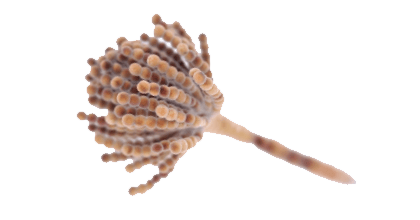
 These mycotoxins are referred to as regulated mycotoxins because their maximum allowable concentrations are established by various authorities.
These mycotoxins are referred to as regulated mycotoxins because their maximum allowable concentrations are established by various authorities.However, the world of mycotoxins is vast, with more than 700 mycotoxins and fungal metabolites identified to date2.
⇰ Most of them fall into the category of non-regulated or emerging mycotoxins.
After mycotoxins are produced, they cannot be easily removed from crops and when contaminated feedstuffs are fed to farm animals, a wide range of negative effects on animal production and health may occur.
 A common risk mitigation strategy is to detoxify mycotoxins within the animal by using mycotoxindeactivating feed additives.
A common risk mitigation strategy is to detoxify mycotoxins within the animal by using mycotoxindeactivating feed additives.
MYCOTOXIN DETOXIFICATION – STATE OF RESEARCH
To mitigate the adverse effects of mycotoxins in animal feed, various strategies have been developed, focusing either on preventing their absorption or on transforming them into less harmful compounds.
Two widely studied approaches are adsorption and biotransformation, each with distinct mechanisms and applications.
Mycotoxin adsorption
Adsorption involves mycotoxins adhering to the surface of an adsorbent, often clay minerals, to reduce their harmful effects.
The effectiveness of adsorption is influenced by several factors, including:
 The pH of the environment
The pH of the environment
 The presence of other substances
The presence of other substances
 The specific properties of the mycotoxins and adsorbents involved
The specific properties of the mycotoxins and adsorbents involved
Mycotoxin biotransformation
Biotransformation refers to the degradation of mycotoxins through the action of microbes or their enzymes.
⇰ This process converts toxic mycotoxins into less toxic or non-toxic forms via microbial activity.
Various microorganisms, including bacteria, fungi, and yeasts, have been identified for their ability to biotransform mycotoxins.
The biotransformation process can involve several biochemical reactions, such as hydroxylation, oxidation, and de-epoxidation, which modify the chemical structure of mycotoxins, rendering them harmless.
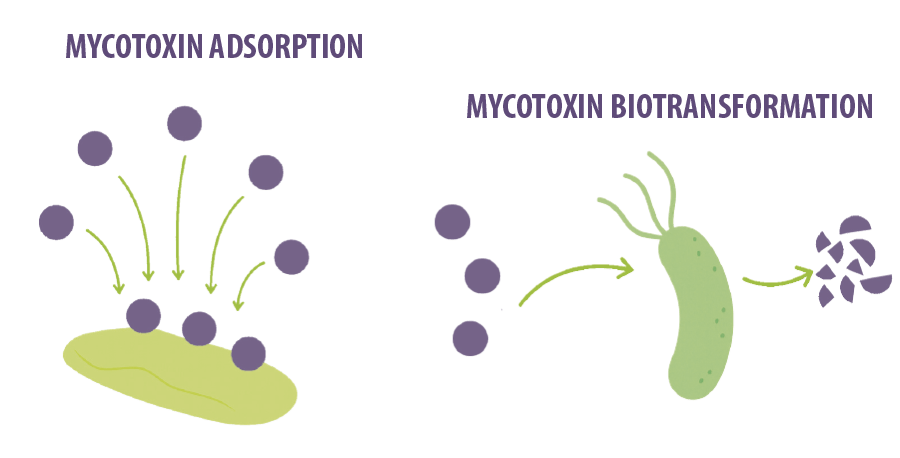
Figure 1. Schematic representation of two mycotoxin detoxification strategies in animal nutrition. On the left, adsorption is illustrated as the binding of mycotoxins (purple circles) to the surface of an adsorbent (green surface), preventing their absorption in the digestive tract. On the right, biotransformation is shown as the microbial degradation of mycotoxins into non-toxic fragments (purple wedges), reducing their harmful effects through enzymatic activity.
MULTILAYERED MYCOTOXIN MANAGEMENT SOLUTION 
MYCORAID is a premium product for mycotoxin risk management, used for the remediation of mycotoxins and other biotoxins in all animal species.
It has proven to be highly effective against a broad spectrum of biotoxins—including mycotoxins, endotoxins, and algal toxins—present in feed, and helps ensure that the gastrointestinal tract, liver, kidneys, and other organs function without interference from toxins.
Due to its unique composition and mode of action, it supports the optimal functioning of the immune, hepatic, reproductive, and digestive systems under commercial conditions.
 Fast and efficient adsorption, effective biotransformation, strong immunoprotection, and continuous hepatoprotection are what make it a superior, multilayered mycotoxin control product.
Fast and efficient adsorption, effective biotransformation, strong immunoprotection, and continuous hepatoprotection are what make it a superior, multilayered mycotoxin control product.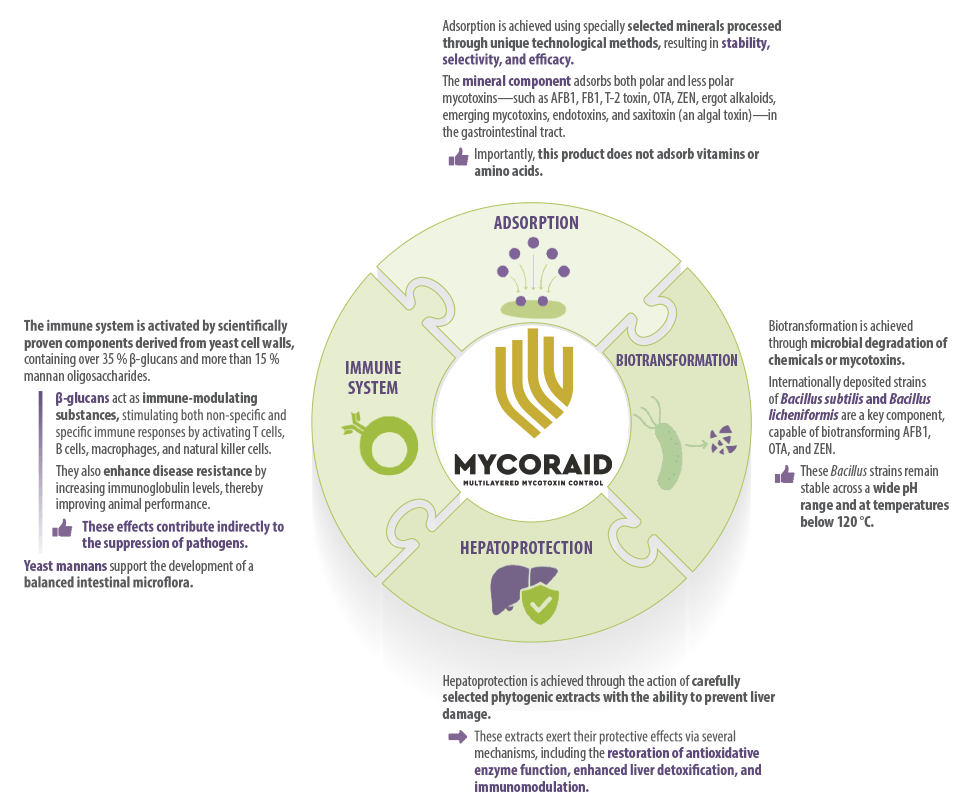
EFFICACY OF MYCORAID IN THE REAL WORLD 
The efficacy of the product has been tested in numerous in vivo trials conducted worldwide3,4.
 It improves production parameters (growth, feed conversion), fertility, immune response, and reduces mortality.
It improves production parameters (growth, feed conversion), fertility, immune response, and reduces mortality. Successful colonization of the intestine by Bacillus strains has been demonstrated—an essential requirement for the biotransformation of mycotoxins.
Successful colonization of the intestine by Bacillus strains has been demonstrated—an essential requirement for the biotransformation of mycotoxins. Its ingredients are thermostable under standard animal feed processing conditions.
Its ingredients are thermostable under standard animal feed processing conditions.
While the restoration of performance is an indication of successful mycotoxin deactivation, only biomarker testing in animal tissues can provide a complete picture.
 MYCORAID has been shown to successfully reduce mycotoxin concentrations in tissues such as liver and muscle in both poultry and swine, providing clear evidence of mycotoxin deactivation.
MYCORAID has been shown to successfully reduce mycotoxin concentrations in tissues such as liver and muscle in both poultry and swine, providing clear evidence of mycotoxin deactivation.The recommended dosage depends on the level of mycotoxin contamination in animal feed.
⇰ To accurately estimate contamination levels, advanced analytical methods such as LC-MS/MS should be used.
This method is employed at the PATENT CO. laboratory in Serbia to test for 34 different mycotoxins in a single run5.

CONCLUSIONS ![]()
Mycotoxin contamination of feed leads to significant performance losses in farm animals.
MYCORAID is an advanced solution designed to combat a broad spectrum of biotoxins—including polar and less polar mycotoxins, endotoxins, and algal toxins—while supporting both liver and immune system function.

References
1. Raj et al. 2021 https://doi.org/10.1080/19440049.2021.20126002
2. Sulyok et al. 2024 https://doi.org/10.1038/s41538-024-00294-73
3. Riahi et al. 2021 https://doi.org/10.3390/ani111132054
4. Tassis et al. 2024 https://doi.org/10.3389/fvets.2024.13577235
5. Farkas et al. 2017 https://mycotoxinsite.com/analisismultimicotoxinas-avanzado-agilent-6460c-lc-ms-ms/
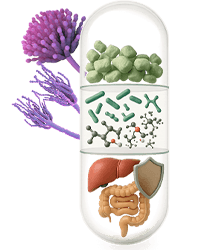
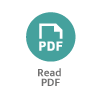





 Micotoxicosis prevention
Micotoxicosis prevention